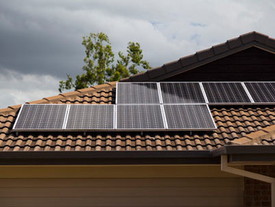 Photovoltaic (PV) technology, which converts sunlight to usable energy, is experiencing a surge in demand as consumers look for alternative energy sources. Federal and state incentives encourage homeowners to install PV technology, and a wider variety of applications offers options to meet budgetary and geographic needs.
Photovoltaic (PV) technology, which converts sunlight to usable energy, is experiencing a surge in demand as consumers look for alternative energy sources. Federal and state incentives encourage homeowners to install PV technology, and a wider variety of applications offers options to meet budgetary and geographic needs.
Raising the Roof
Incorporating PV technology into the roof of the home can be achieved in various ways, using different products. Elevated panels, roofing shingles, tiles, and manufactured slates that integrate PV technology are the most common products for PV roof applications. Vermont-based groSolar mounts traditional solar panels on roofs or on the ground. Their roof-mounted panels are elevated from the roof surface on a rack. “The roof panels look like a skylight,” says Bob Lewis, Sales Manager for groSolar. “We try to keep the architecture in mind, and mount the panels flush with the roof whenever we can.”
Some PV products double as roofing material to supply electricity to the home and keep it protected from the elements. “Our Sunslates are really just a variation on the dominant roofing material in Europe,” says Joe Morrissey of Atlantis, a company with Swiss origins that manufactures a fiber-cement slate roofing product with an applied PV face. “It’s essentially a triple-lap shingle,” he says. Sunslates are designed to be installed with a counter-batten roof, which helps reduce heat build-up in the attic and under the tiles. “With these PV systems, it’s all about avoiding heat,” adds Morrissey. “The more heat you can get off the roof and away from the cells the better.”
Installation
Installing a PV roof system is far less invasive and extensive than some might believe. Depending on the size of the system, an installation can take as little as two days. Basic installation procedures follow fairly straightforward steps. The PV materials are mounted or installed on the roof and connected to one another (the panels, shingles, tiles, etc. are wired to one another in line). A conduit is run down to an inverter box (which turns the DC solar power into usable AC) that runs into the distribution panel. “When the clean energy hits the breaker it looks for things in the home that need energy,” explains Lewis of groSolar’s system.
Roof orientation can be a factor when it comes to installation. A south-facing roof is best for solar energy systems, but some systems provide a bit of leeway to allow for east or west-facing roofs. “Where we are, 15º west of South is true South or ‘solar South'” says Lewis. “We can install on an east or west roof, as long as it is still a viable option.” Companies like groSolar perform on-site evaluations to determine and design a system prior to installation. Roof pitch can also play a part in installation time, cost, and viability. A certified installer can evaluate the roof to determine its suitability. Hiring a certified installer will also protect the system’s warranty. “We sell to certified installers, Morrissey says, “and we back our roofs for 25 years and the power system for 20.”
Cost
Calculating the up-front cost of a system depends on a host of variables, including the size of the system, which is rated by energy produced in Watts or kilowatts, installation factors like the pitch and orientation of the roof, geographic location, and any federal or state incentive programs that could reduce the cost.
Homeowners looking to install a PV system should also utilize any existing net metering programs in their area, which allow excess power generated beyond what the home requires to be fed back to the grid. The result is a backward-spinning meter and a credit on the electric bill toward future energy needs.
Credit: Renovate Your World




























